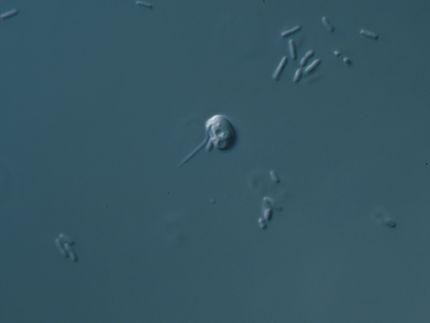Kiwi bird genome sequenced
Researchers of the University of Leipzig and the Max Planck Institute for Evolutionary Anthropology have now sequenced the genetic code of this endangered species and have identified several sequence changes that underlie the kiwi’s adaptation to a nocturnal lifestyle: They found several genes involved in colour vision to be inactivated and the diversity of odorant receptors to be higher than in other birds - suggesting an increased reliance on their sense of smell rather than vision for foraging. The study was published in “Genome Biology”.
The kiwi, national symbol of New Zealand, gives insights into the evolution of nocturnal animals. Its unusual biological characteristics make the flightless kiwi a unique kind of bird. Kiwi have a number of features that make them interesting for study: They only have rudimentary wings, no tail and a very long beak with nostrils. They are mainly nocturnal with a low basal metabolic rate and the lowest body temperature among birds. To date there has been little genetic information available for this species that might help scientists to understand their unusual biology better.
An international team led by Torsten Schöneberg of the Institute of Biochemistry of the Medical Faculty at the University of Leipzig and Janet Kelso of the Max Planck Institute for Evolutionary Anthropology have now sequenced the genome of the brown kiwi (Apteryx mantelli). Their analyses show genetic changes that likely reflect adaptation to nocturnal life. Although mutations have inactivated some of the key genes involved in color vision, the number of odorant receptor genes is expanded suggesting that the kiwi sense of smell is highly developed. These changes happened about 35 million years ago which is after the kiwi’s arrival in New Zealand.
“Already French botanist and zoologist Jean Baptiste de Lamarck, who lived in the 18th century, hypothesized that evolution works in accordance with a ‘use it or lose it’ principle. It is therefore very likely that the kiwi lost its color vision since this was no longer needed for its new nocturnal lifestyle”, says first author Diana Le Duc, MD, at the University of Leipzig. “The kiwi’s sense of smell – which was required for foraging in the dark of the night – became more acute and the repertoire of odorant receptors increased adapting to a wider diversity of smells.”
DNA analyses of two kiwi individuals show, however, that according to first estimates there is little genetic variability in the population. This could further endanger the survival of this species and will have to be taken into account when planning future breeding programs. “The genome of the kiwi is an important resource for future comparative analyses with other extinct and living flightless birds”, says computational biologist Janet Kelso of the Max Planck Institute for Evolutionary Anthropology.
Original publication
Most read news
Original publication
Le Duc D., Renaud G., Krishnan A., Sällman Almén M., Huynen L., Prohaska S.J., Ongyerth M., Bitarello B.D., Schiöth H.B., Hofreiter M., Stadler P.F., Prüfer K., Lambert D., Kelso J., Schöneberg T.; "Kiwi genome provides insights into evolution of a nocturnal lifestyle"; Genome Biology, 2015.
Organizations
Other news from the department science

Get the life science industry in your inbox
By submitting this form you agree that LUMITOS AG will send you the newsletter(s) selected above by email. Your data will not be passed on to third parties. Your data will be stored and processed in accordance with our data protection regulations. LUMITOS may contact you by email for the purpose of advertising or market and opinion surveys. You can revoke your consent at any time without giving reasons to LUMITOS AG, Ernst-Augustin-Str. 2, 12489 Berlin, Germany or by e-mail at revoke@lumitos.com with effect for the future. In addition, each email contains a link to unsubscribe from the corresponding newsletter.





















































